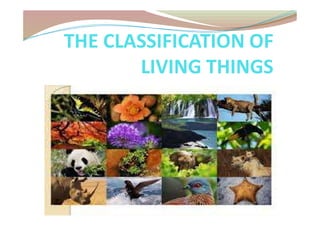
Classification of living things
- 1. THE CLASSIFICATION OF LIVING THINGS
- 2. KINGDOMS OF LIVING THINGS Living things are classified into groups called kingdoms. Living things from the same kingdom share (compartir) similar characteristics. There are five kingdoms: -Animal kingdom -Plant kingdom -Fungi kingdom -Protist kingdom and -Monera kingdom
- 3. ANIMAL KINGDOM Animal are multicellular. They feed on other living things. Most animals can move about.
- 4. PLANT KINGDOM Plants are multicellular. They make their own food. Plants cannot move about because they are fixed by roots.
- 5. FUNGI KINGDOM Fungi can be unicellular or multicellular. They feed on other living things and cannot move about.
- 6. PROTISTA KINGDOM Protists can be unicellular or multicellular. Some protists, like algae, can make their own food.
- 7. MONERA KINGDOM Monerans are unicellular. This kingdom includes bacteria. Some bacteria can make their own food.
- 8. THE ANIMAL KINGDOM Animals are multicellular organisms that eat other living things and can move about. They are divided into two groups: vertebrates and invertebrates.
- 9. VERTEBRATES All vertebrates have an internal skeleton made up of bones. This skeleton includes a backbone, which consists of ring-like bones called vertebrae. They can be: - Mammals - Birds - Reptiles - Amphibians and - Fish
- 10. Mammals They are viviparous. Their bodies are covered with fur or hair. They breathe with lungs. Most mammals have legs.
- 11. Birds They are oviparous. Their bodies are covered with feathers. They breath with lungs. They have two legs and two wings.
- 12. Reptiles They are oviparous. Their skin is covered with scales. They breath with lungs. Most reptiles have legs.
- 13. Amphibians They are oviparous. They breath through gills (branquias) when they are young, and with lungs when they are adults. Adult amphibians have legs.
- 14. Fish They are oviparous. Their bodies are covered with scales. They breath through gills. They have fins (aletas).
- 15. INVERTEBRATES Invertebrates do not have an internal skeleton made up of bones, so they do not have a backbone. Most invertebrates are oviparous. Invertebrates are classified into six groups: -Sponges -Cnidarians -Worms -Molluscs -Echinoderms and -Arthropods
- 16. THE PLANT KINGDOM Plants are multicellular living things that can make their own food and cannot move about. All plants can be classified into two main groups: - Non-seed plants and - Seed plants.
- 17. Non-seed plants Non-seed plants do not produce flowers and seeds. They reproduce with spores. Spores can form new plants. There are two types of non-seed plants: Mosses and ferns.
- 18. Mosses Mosses are very small plants. They live in humid and shady places, and grow on rocks, tree trunks and in the ground. They have tiny stems and leaves.
- 19. Ferns Ferns are much larger than mosses. They also live in humid and shady places. They have large leaves called fronds.
- 20. Seed plants Seed plants reproduce with seeds. There are also two types of seed plants: gymnosperms and angiosperms.
- 21. Gymnosperms Gymnosperms produce seeds, wich are grouped together in cones. They are evergreen trees and shrubs with needle or scale-shaped leaves. Pine trees and firs are gymnosperms.
- 22. Angiosperms Angiosperms produce flowers and fruits which contain seeds. They can be deciduous or evergreen trees, shrubs or grasses. Some examples are apple trees, lavender, grass and poppies (amapolas).
- 23. THE FUNGI KINGDOM Fungi are different living things from plants and animals. Like plants, they cannot move about and many of them grow in soil. Like animals, fungi cannot make their own food. Fungi can feed on other organisms or their remains. Therefore, they can be found not only on the ground, but also on pieces of wood or on decomposing food.
- 24. Fungi are classified into two groups: Unicellular fungi, like yeasts (levaduras). Multicellular fungi, like mushrooms and moulds (moho).
- 25. Many fungi are beneficial to people but others can be harmful. Beneficial fungi: Some fungi can produce edible (comestible) mushrooms. Some medicines, like penicillin, are produced by fungi. Harmful fungi: Some fungi can produce poisonous mushrooms. Athlete´s foot is an infection caused by a fungus.
- 26. THE PROTISTA KINGDOM Protists include two very different types of organisms: Algae and protozoa.
- 27. Algae Algae are aquatic living things that can be unicellular or multicellular. They can make their own food. Some multicellular marine algae can grow to a very large size. Algae are very nutritius, so they are used as food in many countries. They are also used as fertilizer and to produce cosmetics.
- 28. Protozoa Protozoa are unicellular living things that live in aquatic environments. They feed on other organisms. Some protozoa can cause diseases, like malaria.
- 29. THE MONERA KINGDOM Monerans are unicellular living things. This kingdom includes bacteria, the most abundant of all living things.
- 30. Bacteria Bacteria are the smallest and the simplest living things, and can only be seen through a microscope. Most bacteria feed on other organisms, but some bacteria make their own food. Bacteria can be found everywhere in the world. They can live in all kinds of environments: in water, soil, air or inside other living things. Some bacteria are helpful, like the ones used to make yoghurt, but others are harmful, like the ones that causes cholera.